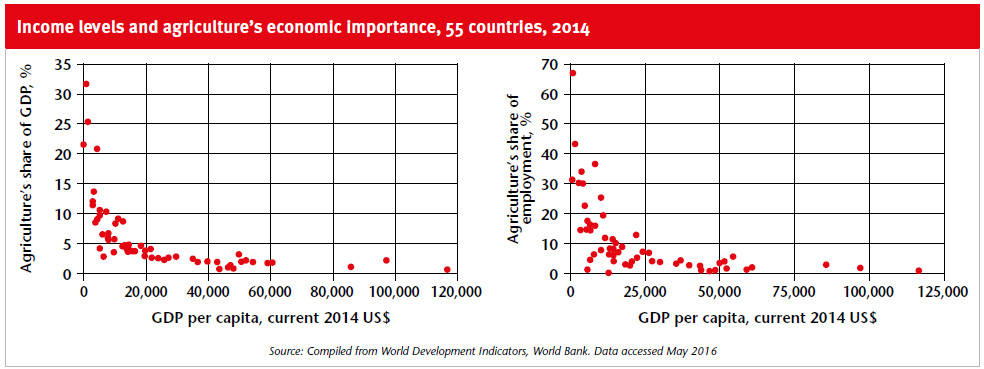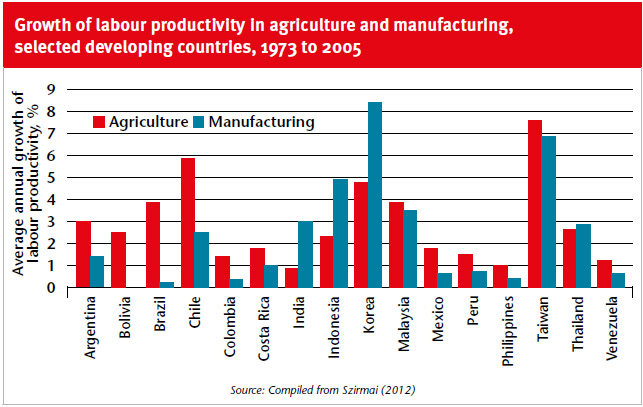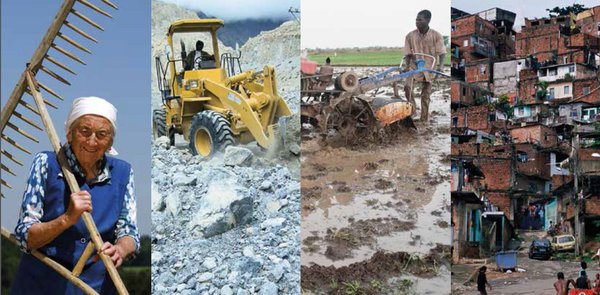 Download this article in magazine layout
Download this article in magazine layout
- Share this article
- Subscribe to our newsletter
Structural transformation and the future of agriculture
Economic development, ever since the industrial revolution that began in the late eighteenth century, has almost always been accompanied by structural change. Agriculture, although growing absolutely, declines in relative importance within the economy in its share of both gross domestic product and employment. Manufacturing and services see their shares of GDP and employment increase (Breisinger et al. 2011, Duarte & Restuccia 2010, Herrendorf et al. 2013, Szirmai 2012, Timmer 2009). At any given moment, comparing countries by their GDP per capita shows the close correspondence of this measure to both the share of output from agriculture and the share of employment in agriculture (see Figure below).
There’s a simple reason for this: as economies grow, incomes rise, but people spend proportionately more of their extra wages on manufactured goods and services, and proportionately less on food (Engel’s Law). Hence with economic growth, demand for the former grows faster than demand for farm output.
Changing importance of sectors is matched by changed location of economic activity. A growing economy will tend to urbanise, with increasing shares of economic output and jobs taking place in towns and cities: correspondingly rural activity, although growing, declines relatively. There’s a simple reason for this as well: most activities that are not tied to land or some other natural resource, as is agriculture, are best carried out in urban areas. That is because agglomeration brings economies (Henderson et al. 2001, Henderson 2013, Quigley 2008). Not only does locating in cities tend to reduce transport costs for individual firms, but also, firms benefit collectively from economies in provision of power, water and other services, from being close to a large and diverse pool of labour, from technical advances that develop in one industry but have applications in others, from face-to-face communications with other firms in the supply chain, and from less variation in demand and supplies when located in large urban centres. Drawbacks of urbanisation in congestion, pollution and high rents for prime urban locations are, for most manufacturing and services, outweighed by the benefits or urban location.
These economic and geographical changes are accompanied by demographic changes. Most obviously, urban population grows, in part fuelled by migration out of rural areas. Less obvious is that countries undergoing economic and geographical transformations are usually experiencing a demographic transition from high to low rates of birth and death, during which population grows rapidly. A slowing of population growth as the demographic transition proceeds accompanies structural transformation. Dependency ratios fall so that the share of the population in working age rises: a demographic dividend that applies until the population begins to age (Eastwood & Lipton 2012, Timmer 2009).

All of today’s high-income and middle-incomes countries have seen these changes, whether they be the early industrialisers of the eighteenth century, or the more recent emerging economies where industrialisation has taken place in the last fifty or so years.
What drives these changes?
Structural change is both a result of economic growth and a cause of it. Labour productivity in manufacturing industry is commonly three or more times larger than that in agriculture in developing countries (Szirmai 2012), so that when labour moves from farm to factory, output rises rapidly. This is why it has long been thought (see, for example the ideas of Lewis 1958) that developing countries could, by industrialising, grow much faster than already industrialised countries. East Asia in the second half of twentieth century has shown, with a vengeance, just how powerful this motor of development can be. Late industrialising countries have grown far faster than the early industrialisers did (Szirmai 2012).
But what if the attractions of manufacturing lead to a mass exit of labour from agriculture and loss of production on farms? This has usually not happened: labour productivity on farms has risen sufficiently to ensure that agricultural growth has at least matched population growth in industrialising countries. What’s more, in many cases, with China as the prime example, a burst of agricultural development took place before the take-off of manufacturing, thereby making it possible to shift labour from farm to factory, while agricultural output increased rapidly enough to hold down food prices – to the great benefit of urban workers (Tiffin & Irz 2006).
What does this imply for agriculture?
Agriculture plays a remarkably important role in these transformations: remarkable because agriculture is the sector in relative decline. The paradox is that the faster agricultural productivity rises, the faster the transformation can take place (Timmer 2009). This is because with rising productivity, above all of labour, agriculture can still grow – thereby producing food and raw materials for the domestic market, and often earning vital export revenue – while releasing labour and capital for the urban economy of manufacturing and services. This may seem a tall order, yet across much of the world labour productivity in agriculture has risen faster than that in manufacturing in recent decades (see Figure, also Christiaensen et al. 2011, Martin & Mitra 2001).

In part, productivity has risen because agriculture in many developing countries had such low levels of productivity, so large increases were potentially possible; but that potential has been realised by the application of improved technology, most notably the improved seed of the Green Revolution, accompanied by public investments in rural roads, power, rural education, health, clean water and the research that has helped produce technical improvements.
Hence the single most important issue for farming remains that of raising productivity, above all labour productivity, as ever it has been. With rapid economic growth of manufacturing and services and urbanisation, however, the circumstances differ to those that typically apply in low income countries in the early stages of development. The difference lies above all in rural labour. Labour is often abundant in rural areas of low-income countries in the early stages of development, but that becomes ever less so, owing to changes in both demand and supply of labour. Demand increases from more intensified forms of farming, from a growing rural non-farm economy – partly stimulated by agricultural growth, and from the jobs on offer in the urban economy.
On the supply side, while the demographic transition is usually delayed in rural areas compared to urban areas, falling fertility, seen almost universally in the last fifty years in rural areas, means that sooner or later the natural growth of rural populations slows and eventually reverses. In thirteen out of sixteen developing countries, census data show that infant cohorts of 0 to 5 years of age were smaller in the late 2000s and early 2010s than before. Increases in population thus arise from large youthful cohorts, the product of past high fertility, making their way through the population structure. Hence, the combination of slowing natural growth and net out-migration from rural areas will soon lead to falling rural populations; as already in evidence in parts of Latin America, East and Southeast Asia (Keats & Wiggins 2016).
The future of agriculture in the developing world is that of farming with less labour. Given that this has been the reality of agriculture in high-income countries for a century or more, technical options to do this are well known. Increasingly farm operations that can readily be mechanised, at modest cost, will be. This does not mean large tractors and combines: more likely it means two-wheel cultivators at first. Neither does this mean sudden conversion to the almost-fully-mechanised operations seen, for example, in the US Midwest. Plenty of operations will continue to require manual work: harvesting of most fruit and vegetables, picking coffee, for example.
Two economic issues thus arise for policy-makers. One concerns scale of farming and consolidation. Mechanisation undercuts some of the advantages of farming at very small scale (Otsuka et al. 2016) in supervising labour. Operated farm sizes are thus likely to increase. Since this point is open to misinterpretation, a couple of clarifications are in order. One is that the increase in scale will usually be from very small to small scale: not large scale and probably not even medium. Operated holdings should rise from, in many parts of Asia, less than two hectares to five to ten hectares. Why not larger? Family farms will still have advantages in carrying out most operations with household labour, or with close supervision of hired hands and contracted machinery. This is the pattern seen across most of the high-income countries: industrialised farming of pigs, poultry, horticulture aside, almost all farming is carried out by family-managed holdings. With part-mechanisation, for many family-managed farms, ten hectares will be the limit of what can be comfortably operated. In time, sizes may well increase, but such change is likely to take place over the medium rather than the short term.
The other clarification is that consolidation will probably be in operations, not ownership. The operation of land can be transferred to households that specialise in farming through renting and sharecropping from households that have their earnings from non-farm jobs, without the latter losing their land. In some cases, informal arrangements set within customary tenure will allow this: village surveys often show lively local markets in rights to operate land. In other cases, tenure policy needs to provide legal recognition of both the rights of potentially vulnerable land users and of the exchanges agreed.
The second policy matter concerns the rural non-farm economy. This will increasingly provide rural jobs. Policy needs to stimulate such activity. Fortunately, most of the policy needed – an enabling rural investment climate, provision of rural public goods – overlaps with that of agricultural development (Wiggins 2014). In particular, rural people need to have the skills and capacity to take up non-farm jobs. That means provision of schooling, health care and clean water so that young adults can take up jobs off the land, perhaps with additional training for which schooling is a precondition.
What are the social implications?
Economic inequality is high in most rural areas of the developing world (Losch et al. 2012), as are often social differences. Not all rural households will find it easy to adapt to transformations. Those households with few assets, on low incomes, already vulnerable to shocks, could find themselves threatened by loss of jobs they can do, or are used to doing, or to loss of land. This is not to suggest that the future is gloomy for those on low incomes: labour shortage will drive up unskilled wages in rural areas, as it already has across much of East and Southeast Asia (Wiggins & Keats 2014), to the benefit of such households.
Three sets of policies can assist low-income households during transformation. One, most clearly social protection can ensure that whatever changes are taking place, individuals and households do not become worse off. Considerable experience has been gained over the last twenty or so years in cash transfers, employment schemes and pensions that protect living standards and ensure that children from such backgrounds get a decent start in life. Two, many farm households that may get the bulk of their incomes from off the farm, and increasingly so, will continue to farm at least some of their land; often on a (very) small scale, part-time. For those on low incomes with little access to capital, technology that raises productivity in such circumstances is valuable. Often such technology exists, even if it may not appeal to those agronomists who want to see state-of-the-art innovations – but which demand too much capital, labour or know-how for marginalised farmers. Ensuring that such farmers have support to make improvements, however limited, is an important challenge for ministries of agriculture. Three, women as farmers are often disadvantaged in access to land, water, inputs, technical knowledge and markets (FAO 2011, World Bank & ONE 2014). Remedying these deficits is especially important during transformations.
To these three issues may be added an overall social challenge: migration. Almost all rural areas will see out-migration to urban areas. It runs against history to imagine that this will not be so; it runs against evidence (World Bank 2013) to imagine that urbanisation will not, on balance, enhance welfare. Many developing world governments have schizophrenic policy for migration. On the one hand, they try to deter movement. On the other, they invest more in services in cities, making them more attractive places to live in than rural areas. The former policies have done little to stem migration, but rather have raised costs and dangers to migrants.
Better policy would seek to facilitate rural household choices. Providing information on opportunities and costs at destinations could help; as could reducing the cost of sending remittances; protecting the rights of migrants as workers, and their rights to public services such as education and health care. Developing rural financial services could avert migration undertaken largely to accumulate capital to invest back in the village.
Summing up ...
Economic transformation that sees agriculture become less important relative to manufacturing and services, with urbanisation, is a longstanding and universal feature of development. The policy challenge is to facilitate such transformation, to make it not only effective and efficient, but also socially equitable. The coming rural economy will see less labour used in agriculture: agricultural output will only grow if labour productivity rises. It will see incremental mechanisation, some consolidation of operated holdings and rising rural wages.
Socially there are dangers for those on low-incomes and vulnerable to shocks, with social protection as a key response. Rural areas will also continue to see net out-migration: a process that needs facilitation rather than obstruction.
Steve Wiggins
Research Fellow
Overseas Development Institute
London, United Kingdom
s.wiggins@odi.org.uk
References and further reading
- Africa Center for Economic Transformation – ACET (2014): Growth with depth. 2014 African Transformation Report, Accra: ACET.
- Breisinger, Clemens, Xinshen Diao, Shashidhara Kolavalli, Ramatu Al Hassan & James Thurlow (2011): A new era of transformation in Ghana. Lessons from the past and scenarios for the future, Research Monograph, Washington DC, International Food Policy Research Institute.
- Christiaensen, Luc, Lionel Demery & and Jesper Kuhl (2011): ‘The (Evolving) Role of Agriculture in Poverty Reduction. An Empirical Perspective’, Working Paper No. 2010/36, Helsinki: UNU Wider.
- Duarte, Margarida, and Diego Restuccia (2010): “The Role of the Structural Transformation in Aggregate Productivity.” The Quarterly Journal of Economics, 125(1): 129–173.
- Eastwood, Robert, and Michael Lipton (2012): "The demographic dividend: retrospect and prospect." Economic Affairs 32, no. 1 (2012): 26-30.
- FAO (2011): The state of food and agriculture 2010/11. Women in agriculture. Closing the gender gap for development, Rome: Food and Agriculture Organization of the United Nations.
- Herrendorf, Berthold, Richard Rogerson & Akos Valentinyi (2013): Growth and Structural Transformation, Prepared for the Handbook of Economic Growth, February 17, 2013.
- IMF (2014): Regional Economic Outlook Sub-Saharan Africa. Fostering Durable and Inclusive Growth, April 2014, Washington DC: IMF.
- Keats, Sharada & Steve Wiggins (2016): Population change in the rural developing world. Making the transition, Report, London: Overseas Development Institute.
- Losch, Bruno, Sandrine Fréguin-Gresh, & Eric Thomas White (2012). Structural transformation and rural change revisited: challenges for late developing countries in a globalizing world. World Bank Publications.
- Martin, Will, & Devashish Mitra (2001): "Productivity Growth and Convergence in Agriculture versus Manufacturing". Economic Development and Cultural Change 49, no. 2 (2001): 403–422.
- Otsuka, Keijiro, Liu, Yanyan & Yamauchi, Futoshi (2016): ‘The future of small farms in Asia’, Development Policy Review, 34 (3), 1467–7679.
- Radelet, Steven (2010): ‘Emerging Africa: How 17 Countries Are Leading the Way’, Center for Global Development, Brief, September 2010, Washington DC: Center for Global Development.
- Szirmai, Adam (2012): Industrialization as an engine of growth in developing countries, 1950-2005, Structural Change and Economic Dynamics, 23(4): 406–420.
- Tiffin, Richard & Xavier Irz (2006). ‘Is agriculture the engine of growth?’. Agricultural Economics, 35, 79–89.
- Timmer, C. Peter (2009): A World without Agriculture. The Structural Transformation in Historical Perspective, Washington DC: AEI Press Publisher for the American Enterprise Institute.
- Wiggins, Steve & Sharada Keats (2014): Rural wages in Asia, Report, London: Overseas Development Institute.
- Wiggins, Steve (2014): ‘Rural non-farm economy: current understandings, policy options, and future possibilities, Chapter 17, Peter B. R. Hazell & Atiqur Rahman (Eds), New directions for smallholder agriculture, 2014, Oxford: Oxford University Press.
- World Bank & ONE (2014): Levelling the field. Improving opportunities for women farmers in Africa, Washington DC: World Bank, and London: ONE.
- World Bank (2007): Agriculture for Development. World Development Report 2008, World Bank, Washington DC.
- World Bank (2009): Reshaping Economic Geography. World Development Report 2009, World Bank, Washington DC.
- World Bank (2013): Global Monitoring Report 2013: Rural-Urban Dynamics and the Millennium Development Goals. Washington, DC: World Bank.





Add a comment
Be the First to Comment